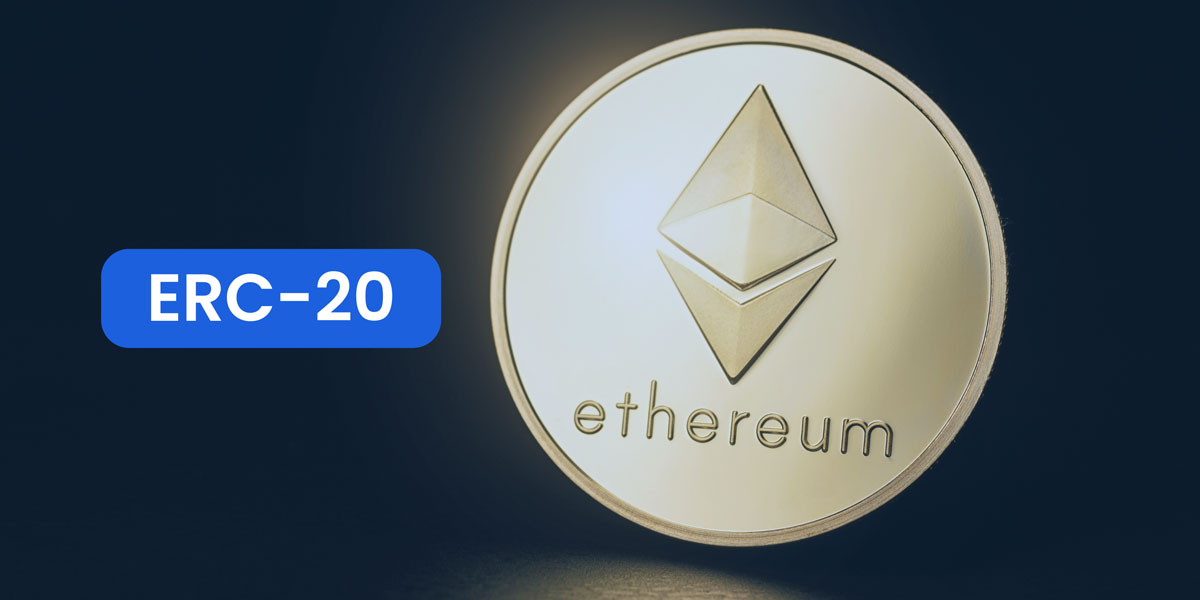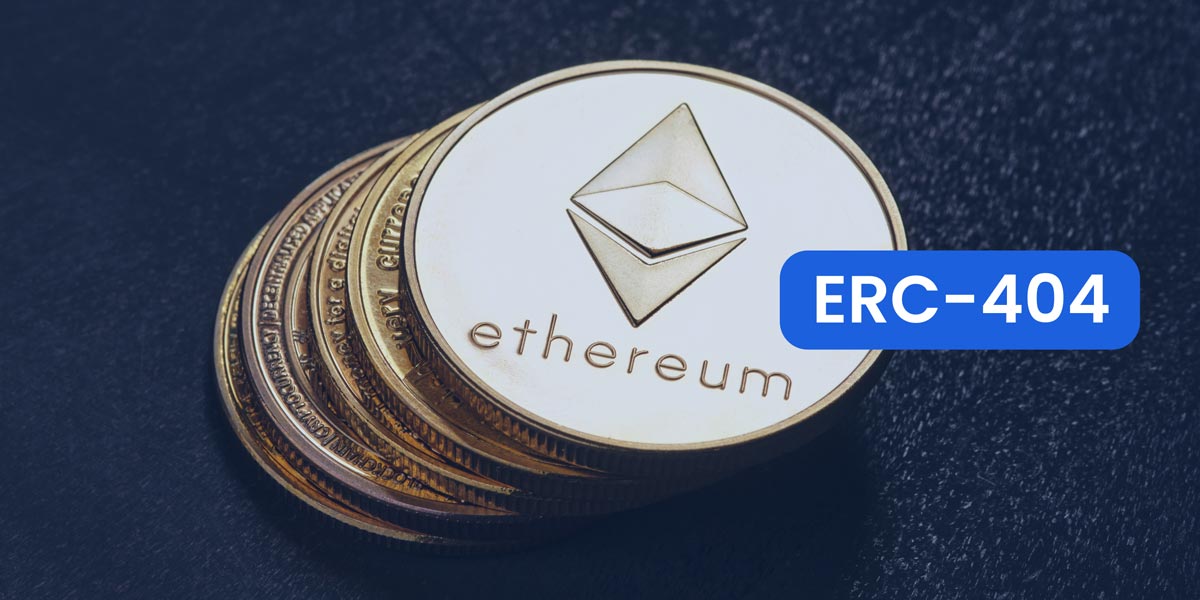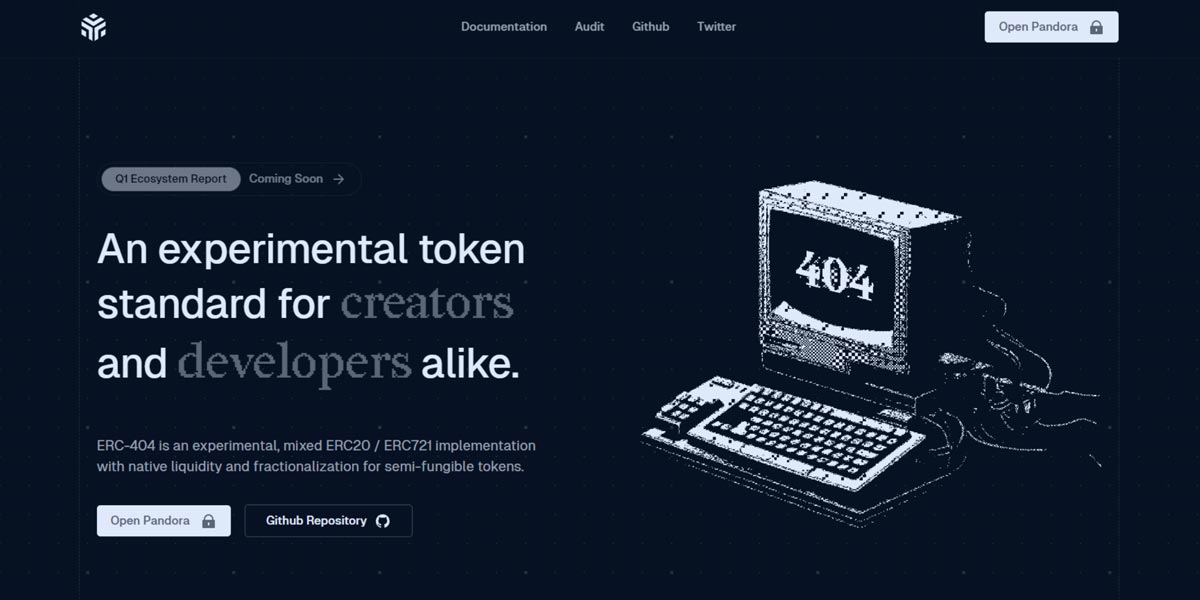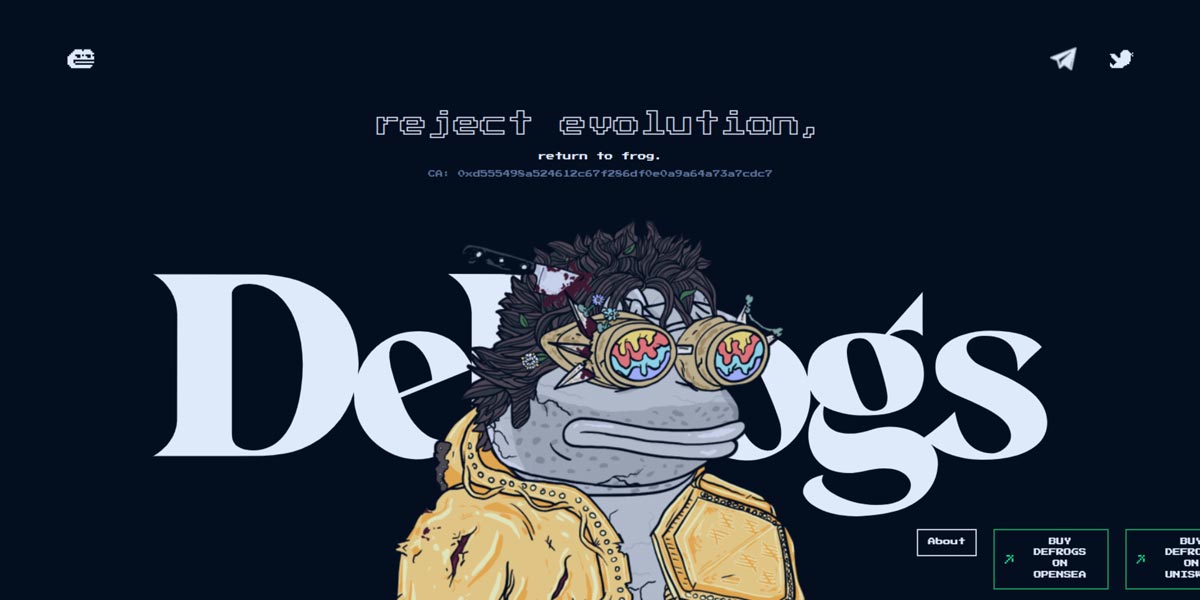If you’ve spent some time exploring the Ethereum blockchain, chances are you’ve encountered ERC-20 tokens. These tokens are the backbone of many DeFi platforms, serving as a universal standard for fungible digital assets. But beyond ERC-20, another token standard has become popular among those intrigued by digital collectables: ERC-721, the standard behind non-fungible tokens (NFTs).
So, what are token standards, and why do they matter? Simply put, token standards define how tokens operate on the Ethereum blockchain. These rules ensure that tokens can interact seamlessly with various applications and services, from wallets to exchanges.
This post spotlights an emerging token standard stirring excitement and curiosity: ERC-404. This new framework introduces innovative concepts to the Ethereum ecosystem, promising to expand digital assets and ownership possibilities.
Token Standards in Ethereum: What are They?

Digital assets are broadly categorised into coins and tokens. Coins, such as Bitcoin, act as the native assets of their respective blockchains. On the other hand, tokens represent assets developed atop existing blockchain frameworks. Take Ethereum, for instance: its native cryptocurrency is Ether (ETH), serving as the fuel for the network’s operations, while a multitude of other digital assets, including the likes of DAI, LINK, and BAT, are tokens built on Ethereum’s platform.
This approach of developing tokens on well-established blockchains, rather than venturing into the creation of entirely new blockchains, has become a favoured route for many projects. It allows them to leverage the established community of platforms like Ethereum. Essentially, most blockchain-based digital assets we interact with today are tokens residing on networks such as Ethereum, which offers a fertile ground for innovation and development.
The concept of tokenisation standards offers a set of rules and technical guidelines that streamline the process of creating new tokens. These standards serve as blueprints, ensuring tokens can effortlessly interact and integrate within the broader digital ecosystem, including wallets, exchanges, and decentralised finance (DeFi) applications.
Interoperability, a key feature facilitated by these standards, is crucial for the seamless operation and adoption of DeFi applications, allowing them to work in harmony with existing and future elements of DeFi.
The Ethereum community, known for its collaborative and decentralised nature, encourages individuals to propose new standards through Ethereum Improvement Proposals (EIPs). These proposals, once submitted, are discussed and reviewed as Ethereum Request for Comments (ERCs), gathering feedback from the community. This process ensures that before a standard is adopted, it undergoes thorough scrutiny and consensus, embodying the decentralised ethos of Ethereum.
ERC-20 is the most popular among these ethereum token standards, widely acknowledged for creating fungible (interchangeable) tokens. This standard has allowed many tokens to integrate seamlessly within Ethereum’s ecosystem. However, it doesn’t stop with ERC-20 and ERC-721.
Recently, ERC-404 has captured the attention of the crypto community, stirring conversations and sparking curiosity. For those closely following these developments, it’s clear that ERC-404 represents an intriguing blend of ERC-20’s fungibility with ERC-721’s distinctiveness (semi-fungible tokens), offering a new approach to token standards on the Ethereum blockchain. While still in the experimental stages, this unofficial token standard hints at new possibilities for token utility and versatility, demonstrating Ethereum’s continuous capacity for innovation and its ability to adapt to the evolving needs of the digital asset market.
What is ERC 404?

ERC-404 is stepping into the spotlight as an intriguing new proposal within the Ethereum ecosystem, introducing the concept for people to create semi-fungible tokens. This experimental token standard, conceived by developers with X usernames “ctrl” and “Acme” from Pandora Labs, aims to bridge the gap between the widespread liquidity found in ERC-20 tokens and the unique, collectable nature of ERC-721 tokens. Though not yet officially put forward as an Ethereum Improvement Proposal (EIP), the buzz around ERC-404’s potential is hard to ignore.
ERC-404 seeks to merge the functionalities of ERC-20 and ERC-721 standards with interchangeable and unique tokens. This dual functionality opens up new possibilities for using smart contract token designs, addressing some of the pressing challenges in the crypto space, such as improving the liquidity of non-fungible tokens (NFTs) and simplifying the process of NFT fractionalisation.
One of the standout features of ERC-404 is its ability to enhance NFT liquidity. Tokens following this standard can be traded on decentralised exchanges or pooled in Automated Market Makers (AMMs) just like any fungible token, breaking new ground for NFT trading. Moreover, ERC-404 introduces native fractionalisation, allowing parts of a token to be traded without needing a separate NFT fractionalisation protocol. This development is being keenly explored for its potential integration with core DeFi protocols, including lending platforms.
Furthermore, ERC-404 tokens bring a new approach to token divisibility. Unlike traditional fractionalised NFTs, these tokens can be split and shared, facilitating a more flexible interaction with what were once strictly non-fungible assets. In the current models being tested, once an NFT is divided and traded, it is burnt, only to be re-minted when enough fractions are gathered to form a whole token again.
This experimental standard is about enhancing the utility and liquidity of tokens and pushing the boundaries of what digital assets can be. By allowing tokens to operate in both fungible and non-fungible states, ERC-404 could pave the way for a new era of digital ownership and exchange, making it a topic of significant interest and speculation within the blockchain community.
How Does the ERC 404 Token Standard Work?
As stated earlier, the ERC-404 token standard introduces a fascinating blend of uniqueness and interchangeability, navigating the complexities of merging the characteristics of ERC-20 fungible tokens with those of ERC-721 non-fungible tokens (NFTs). This approach crafts a new category of tokens that can adapt their form and function to suit different needs within the digital asset ecosystem. Here’s a closer look at how this standard operates.
At the heart of the ERC-404 concept is the intrinsic link between each token and an NFT. This connection means that acquiring an ERC-404 token automatically triggers the minting of a corresponding NFT in a wallet. Similarly, minting an NFT under this standard grants a fungible token representing a stake in that NFT. This dual nature facilitates a unique interaction between digital assets’ fungible and non-fungible aspects.
When it comes to the dynamics of trading these tokens, selling a fraction of an ERC-404 token results in the burning of the associated NFT. Conversely, accumulating sufficient fractions to compile a complete token leads to minting a new NFT. This cycle ensures that each whole token remains directly connected to an NFT, preserving the essence of non-fungibility for the ERC-721 component. The process relies on a mint-and-burn mechanism, pivotal for maintaining the balance between fungibility and uniqueness.
Developers behind ERC-404 have introduced various mechanisms to ensure this balance is maintained. For instance, when fractions of a token are unified to recreate a whole token, a new NFT is generated. This could either be a completely new NFT with potentially different attributes, adding an element of surprise and variation to the process, or it could be a standardised NFT where each recreated token retains identical rarity and characteristics, depending on the specific implementation of the ERC-404 standard within a project.
It’s worth noting that ERC-404 diverges from the traditional path of token standard development within the Ethereum community. As it stands, it hasn’t undergone the usual rigorous auditing process, remaining an experimental standard. This experimental nature means that while it opens up new possibilities for token utility and digital asset management, it also carries potential risks and uncertainties.
Additionally, the standard’s approach to transaction processing and smart contract interactions is designed to be gas-efficient, sparking discussions and potential for further refinement and innovation, such as the DN-404 proposal aimed at enhancing the ERC-404 framework.
In essence, the ERC-404 token standard is breaking new ground in the digital asset market, offering a blend of liquidity, uniqueness, and fractional ownership that could redefine how we interact with tokens on the Ethereum blockchain. Its development and adoption are keenly watched by enthusiasts and developers alike, eager to explore the new avenues and challenges it presents.
Examples of ERC-404 Projects
ERC-404 token standard has ushered in a wave of projects on Ethereum, blending the liquidity and fungibility of ERC-20 tokens with the uniqueness and collectability of ERC-721 tokens. Here’s a closer look at some pioneering ERC-404 projects capturing the crypto community’s attention.
Pandora

Pandora stands as the inaugural functional ERC-404 token, marking a significant milestone with its announcement on February 2, 2024. This project represents a fusion of 10,000 ERC-20 tokens and an equal number of Replicant (ERC-721) tokens, employing a random mint-and-burn model to manage the relationship between the fungible and non-fungible aspects of its tokens.
The concept allows for a Replicant to be burnt when a Pandora token is divided, and a new, random Replicant to be minted upon acquiring a whole Pandora token. Listed on Uniswap shortly after its announcement, Pandora has garnered positive feedback from both the NFT community and ERC-20 token traders, highlighting its innovative approach to token standards.
DeFrogs

Following closely behind Pandora, DeFrogs introduces itself as an adjusted take on the ERC-404 standard. It merges meme culture with the technical narrative of ERC-404, aiming to foster a community centred around its collection of 10,000 cartoon frog PFPs. DeFrogs token debuted through a fair launch on Uniswap, with a significant portion of its supply dedicated to liquidity, demonstrating the project’s commitment to accessibility and community building. This project showcases the versatility of ERC-404 tokens, proving that they can support a wide range of themes and community-focused initiatives.
EtherRock404
EtherRock404, a derivative of the original EtherRock NFT collection, embraces the ERC-404 standard to offer a unique twist on the concept of digital collectables. Billing itself as a ‘zero utility’ project, EtherRock404 focuses solely on the trading of its tokens, each associated with graphics of rocks. This project employs the random mint-and-burn mechanism, ensuring that each purchase of a whole EtherRock404 token results in the minting of a new NFT within the collection. EtherRock404’s approach exemplifies projects’ experimental and often playful nature within the ERC-404 space, pushing the boundaries of what digital assets can represent.
These projects illustrate the dynamic potential of the ERC-404 standard, opening up new possibilities for digital ownership, trading, and community engagement within the Ethereum ecosystem.
As the standard continues to evolve and more projects emerge, the landscape of tokenization and NFTs is set to expand in exciting and unexpected directions.
The Future of ERC 404 Token Standard
Despite being in its early, unofficial stages and facing critique for aspects like transaction costs and handling of the ERC-721 component, the ERC-404 standard represents a bold step forward in the evolution of token standards on the Ethereum blockchain.
The ERC-404 standard is an experimental endeavour, aiming to merge the liquidity and trading ease of fungible tokens with the uniqueness and collectability of non-fungible tokens (NFTs). This hybrid approach could transform how we perceive ownership and trading of digital assets, offering a new form of shared ownership that combines the best of both worlds.
One of the most compelling features of ERC-404 tokens is their promise of enhanced liquidity for high-value digital assets, such as rare digital artwork. By enabling fractional ownership through native fractionalisation, ERC-404 tokens could unlock new avenues for investors and collectors alike, making previously inaccessible assets more attainable.
However, the experimental nature of ERC-404 raises concerns about potential security risks and vulnerabilities. As with any new technology, the balance between fostering innovation and ensuring user security is delicate. The community’s response to these challenges will be crucial in shaping the standard’s future.
Moreover, the support from top-tier exchanges and the integration into prominent Web3 wallets like Binance, OKX, and BitGet highlight the growing industry interest in ERC-404 tokens. Such endorsements could significantly boost the standard’s adoption, offering users new ways to access, trade, and invest in digital assets.
Looking ahead, the developers behind ERC-404 aim to formally propose it as an official Ethereum Improvement Proposal (EIP). This step, while potentially lengthy, is essential for gaining broader acceptance and establishing ERC-404 as a notable project within the Ethereum ecosystem. Yet, the decision to bypass the traditional approval process might encourage a trend of unaudited token standards entering the market, posing new challenges and risks.
Frequently Asked Questions
What is ERC 404?
ERC 404 is an experimental token standard on the Ethereum blockchain that aims to combine the features of fungible tokens (like ERC-20) and non-fungible tokens (like ERC-721) into a single framework. This standard introduces the concept of semi-fungible tokens, offering both uniqueness and liquidity.
How does ERC 404 differ from ERC-20 and ERC-721?
While ERC-20 tokens are fully fungible, meaning each token is identical to another, and ERC-721 tokens are entirely unique or non-fungible, ERC 404 seeks to blend these characteristics. It enables a token to exhibit both fungible and non-fungible properties, depending on its use case.
What are the potential benefits of ERC 404 tokens?
ERC 404 tokens could enhance liquidity for high-value digital assets, facilitate shared ownership, and open new possibilities in the digital asset market. They allow for the fractional ownership of NFTs, making it easier to trade and invest in expensive digital assets.
What challenges does the ERC 404 standard face?
Being an experimental token standard, ERC 404 faces challenges such as potential security risks, the complexity of handling the dual nature of tokens, and the need for broader acceptance within the Ethereum ecosystem. These issues must be addressed for ERC 404 to gain widespread adoption.
Are there any projects using the ERC 404 standard?
Yes, there are several projects exploring the ERC 404 standard, including Pandora and DeFrogs, each with its unique approach to leveraging semi-fungible tokens. These projects showcase the standard’s potential for fostering innovation in the NFT market and beyond.




